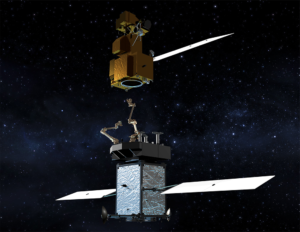
In May, NASA officially moved forward with plans to execute the ambitious, technology-rich Restore-L mission, an endeavor to launch a robotic spacecraft in 2020 to refuel a live satellite. The mission – the first of its kind in low-Earth orbit – will demonstrate that a carefully curated suite of satellite-servicing technologies are fully operational. The current candidate client for this venture is Landsat 7, a government-owned satellite in low-Earth orbit. [Note: Landsat 7 is operated by the U.S. Geological Survey]
Beyond refueling, the Restore-L mission also carries another, weighty objective: to test other crosscutting technologies that have applications for several critical upcoming NASA missions. As the Restore-L servicer rendezvous with, grasps, refuels, and relocates a client spacecraft, NASA will be checking important items off of its technology checklist that puts humans closer to Mars exploration.
Restore-L technologies include an autonomous relative navigation system with supporting avionics, and dexterous robotic arms and software. The suite is completed by a tool drive that supports a collection of sophisticated robotic tools for robotic spacecraft refueling, and a propellant transfer system that delivers measured amounts of fuel at the proper temperature, rate, and pressure.
Future candidate applications for individual Restore-L technologies include on-orbit manufacturing and assembly, propellant depots, observatory servicing, and orbital debris management. NASA is also directly applying several Restore-L technologies to the Asteroid Redirect Mission.
The robotic vehicle of NASA’s Asteroid Redirect Mission directly leverages Restore-L’s autonomous rendezvous system, avionics, dexterous robotics and software, and tool drive and other systems. This mission, along with the Wide-Field Infrared Survey Telescope (WFIRST) observatory, is being designed to be refuelable.
NASA’s second, equally important objective for Restore-L is to infuse its technologies to domestic commercial entities to help jumpstart a new, competitive industry in robotic satellite servicing, an area ripe with possibility.
“Restore-L effectively breaks the paradigm of one-and-done spacecraft” says Frank Cepollina, veteran leader of the five crewed servicing missions to the Hubble Space Telescope. Cepollina now serves as the associate director of the Satellite Servicing Capabilities Office (SSCO), the team that first conceived of the Restore-L concept and developed its technology portfolio.
“It introduces new ways to robotically manage, upgrade and prolong the lifespans of our costly orbiting national assets. By doing so, Restore-L opens up expanded options for more resilient, efficient and cost-effective operations in space,” says Cepollina.
Currently, spacecraft launch to space with a finite amount of fuel, their lifespans restricted by the amount of propellant within their metal spacecraft buses at launch. A refueling capability in space, offered by future propellant-delivery spacecraft similar to Restore-L, could provide satellite owners the ability to manage, maintain, and save their most valuable assets in space.
American industry appears eager to offer such services and has expressed strong interest in this burgeoning field. NASA’s transfer of Restore-L technologies to interested domestic entities could help spur the arrival of such commercial life extension and repair offerings. The Restore-L mission could also help decrease the risk for future servicing ventures and establish a global precedence for safe rendezvous operations in orbit.
Restore-L’s technologies are foundational for other ambitious objectives beyond refueling. “You cannot entirely forecast how the aerospace community will run with new, capability-building servicing technologies, but we can predict likely short-term innovations,” says Benjamin Reed, deputy project manager for SSCO.
“With robotic servicing on the table, satellite owners can extend the lifespan of satellites that are running low on fuel, reaping additional years of service – and revenue – from their initial investment. If a solar array or a communications antenna fails to deploy, a servicer with inspection cameras and the right repair tools could help recover the asset that otherwise would have been lost. The loss of an anticipated revenue or data stream can be devastating,” Reed says.
Servicing capabilities could help satellite owners better manage their space assets in innovative ways. This could include launching a spacecraft with a half-empty fuel tank and allotting the saved weight to mission-specific instruments. “Dependable robotic satellite servicing unlocks countless opportunities,” Reed says.
“NASA’s Space Technology Mission Directorate rapidly develops, demonstrates, and infuses revolutionary, high-payoff technologies – Restore-L embodies these goals and we look forward to realizing its potential,” says Jim Reuter, deputy associate administrator for programs in STMD.
For more information about NASA’s Space Technology Mission Directorate, visit:http://www.nasa.gov/spacetech
Related Reading:
+ Restore-L webpage
+ NASA selects builder for robotic satellite servicing craft, Spaceflight Now

Scenes from the Polar Night
Landsat satellites have begun regularly acquiring images of ice at the poles during the winter, with enlightening results.





